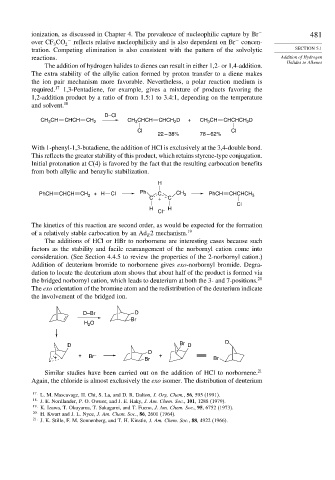Page 500 - Advanced Organic Chemistry Part A - Structure and Mechanisms, 5th ed (2007) - Carey _ Sundberg
P. 500
ionization, as discussed in Chapter 4. The prevalence of nucleophilic capture by Br − 481
−
over CF CO − reflects relative nucleophilicity and is also dependent on Br concen-
3 2
tration. Competing elimination is also consistent with the pattern of the solvolytic SECTION 5.1
reactions. Addition of Hydrogen
Halides to Alkenes
The addition of hydrogen halides to dienes can result in either 1,2- or 1,4-addition.
The extra stability of the allylic cation formed by proton transfer to a diene makes
the ion pair mechanism more favorable. Nevertheless, a polar reaction medium is
required. 17 1,3-Pentadiene, for example, gives a mixture of products favoring the
1,2-addition product by a ratio of from 1.5:1 to 3.4:1, depending on the temperature
and solvent. 18
D–Cl
CH CH CHCH CH 2 CH 3 CHCH CHCH D + CH CH CHCHCH D
2
3
2
3
Cl Cl
22 – 38% 78 – 62%
With 1-phenyl-1,3-butadiene, the addition of HCl is exclusively at the 3,4-double bond.
This reflects the greater stability of this product, which retains styrene-type conjugation.
Initial protonation at C(4) is favored by the fact that the resulting carbocation benefits
from both allylic and benzylic stabilization.
H
PhCH CHCH CH 2 + H Cl Ph C CH 3 PhCH CHCHCH 3
C + C
Cl
H – H
Cl
The kinetics of this reaction are second order, as would be expected for the formation
of a relatively stable carbocation by an Ad 2 mechanism. 19
E
The additions of HCl or HBr to norbornene are interesting cases because such
factors as the stability and facile rearrangement of the norbornyl cation come into
consideration. (See Section 4.4.5 to review the properties of the 2-norbornyl cation.)
Addition of deuterium bromide to norbornene gives exo-norbornyl bromide. Degra-
dation to locate the deuterium atom shows that about half of the product is formed via
the bridged norbornyl cation, which leads to deuterium at both the 3- and 7-positions. 20
The exo orientation of the bromine atom and the redistribution of the deuterium indicate
the involvement of the bridged ion.
D–Br D
Br
O
H 2
D Br D D
D
+ + Br – Br + Br
Similar studies have been carried out on the addition of HCl to norbornene. 21
Again, the chloride is almost exclusively the exo isomer. The distribution of deuterium
17 L. M. Mascavage, H. Chi, S. La, and D. R. Dalton, J. Org. Chem., 56, 595 (1991).
18
J. E. Nordlander, P. O. Owuor, and J. E. Haky, J. Am. Chem. Soc., 101, 1288 (1979).
19
K. Izawa, T. Okuyama, T. Sakagami, and T. Fueno, J. Am. Chem. Soc., 95, 6752 (1973).
20 H. Kwart and J. L. Nyce, J. Am. Chem. Soc., 86, 2601 (1964).
21
J. K. Stille, F. M. Sonnenberg, and T. H. Kinstle, J. Am. Chem. Soc., 88, 4922 (1966).

